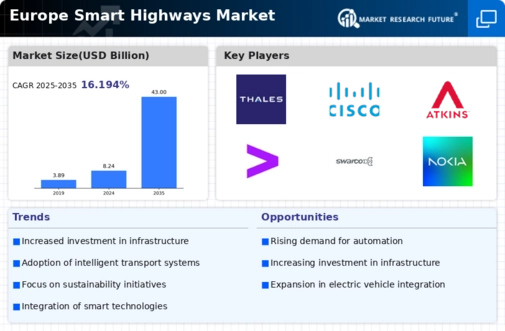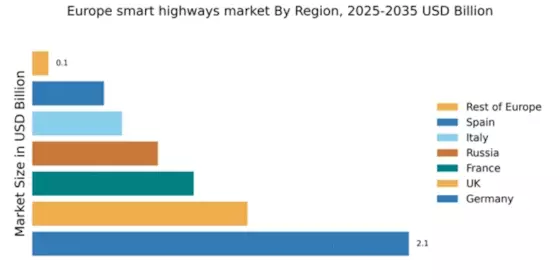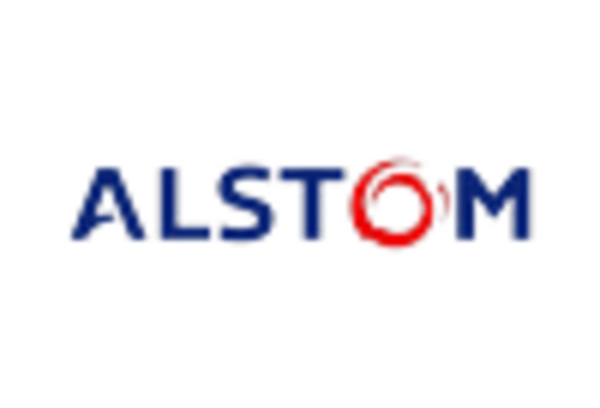Germany : Germany's Pioneering Infrastructure Development
Germany holds a dominant market share of 2.1 in the smart highways sector, driven by robust investments in infrastructure and technology. Key growth drivers include government initiatives aimed at enhancing road safety and efficiency, alongside increasing demand for smart traffic management systems. Regulatory policies support the integration of IoT and AI technologies, fostering innovation in transportation. The country's industrial development is further bolstered by its strong automotive sector, which is increasingly adopting smart highway solutions.
UK : UK's Focus on Sustainable Transport
The UK, with a market share of 1.2, is rapidly advancing in the smart highways domain, driven by a strong emphasis on sustainability and reducing carbon emissions. Government initiatives, such as the Road Investment Strategy, aim to modernize transport infrastructure. Demand for smart solutions is growing, particularly in urban areas, as cities like London and Manchester implement smart traffic systems to alleviate congestion and enhance safety. The competitive landscape features major players like Cisco Systems and Kapsch TrafficCom, who are actively engaging in local projects.
France : France's Commitment to Smart Mobility
France's smart highways market, valued at 0.9, is characterized by innovative solutions aimed at improving traffic flow and safety. Key growth drivers include government policies promoting smart mobility and investments in digital infrastructure. Cities like Paris and Lyon are at the forefront of adopting smart technologies, with initiatives focused on real-time traffic management and environmental sustainability. The competitive landscape includes significant players like Thales Group and Alstom, who are collaborating with local authorities to enhance urban mobility.
Russia : Russia's Strategic Transport Initiatives
With a market share of 0.7, Russia is gradually developing its smart highways infrastructure, driven by government initiatives aimed at modernizing transport systems. The demand for smart solutions is increasing, particularly in major cities like Moscow and St. Petersburg, where traffic congestion is a pressing issue. The competitive landscape features both local and international players, including IBM and Honeywell, who are investing in smart traffic management systems. Regulatory support is crucial for fostering innovation in this sector.
Italy : Italy's Focus on Modernization
Italy's smart highways market, valued at 0.5, is gaining traction as the government prioritizes modernization of transport infrastructure. Key growth drivers include EU funding for digitalization and sustainability initiatives. Demand is particularly strong in urban areas like Milan and Rome, where smart traffic solutions are being implemented to improve mobility. The competitive landscape includes major players like Siemens and Kapsch TrafficCom, who are actively involved in local projects aimed at enhancing road safety and efficiency.
Spain : Spain's Investment in Infrastructure
Spain's smart highways market, with a share of 0.4, is on the rise due to significant investments in infrastructure and technology. Government initiatives focus on enhancing road safety and reducing traffic congestion, particularly in cities like Madrid and Barcelona. The demand for smart solutions is increasing, driven by urbanization and the need for efficient transport systems. The competitive landscape features key players like Cisco Systems and Thales Group, who are collaborating with local authorities to implement smart traffic management solutions.
Rest of Europe : Emerging Markets Across Europe
The Rest of Europe, with a market share of 0.09, showcases diverse developments in the smart highways sector. Various countries are at different stages of adopting smart technologies, driven by local government initiatives and EU regulations. Demand trends vary, with some regions focusing on sustainability while others prioritize efficiency. The competitive landscape includes a mix of local and international players, adapting to regional needs and market dynamics. Sector-specific applications are emerging in logistics and public transport, enhancing overall mobility.


















Leave a Comment